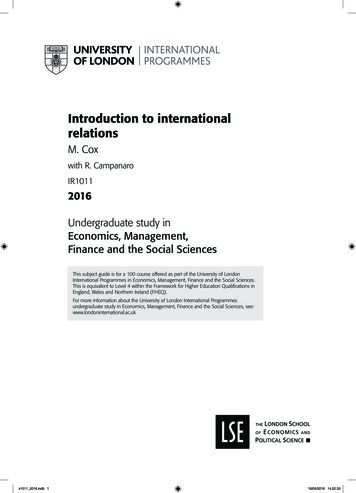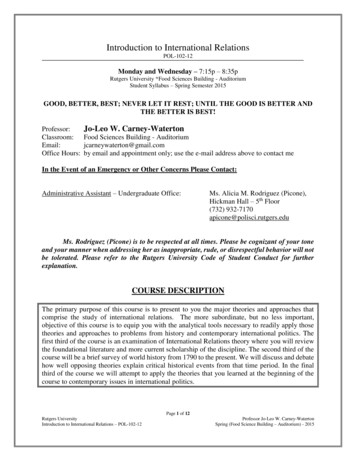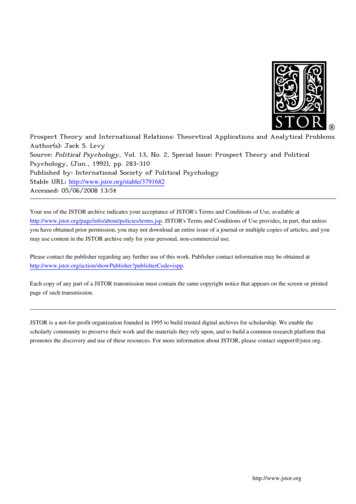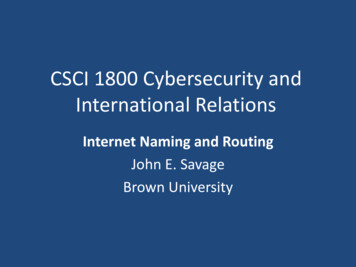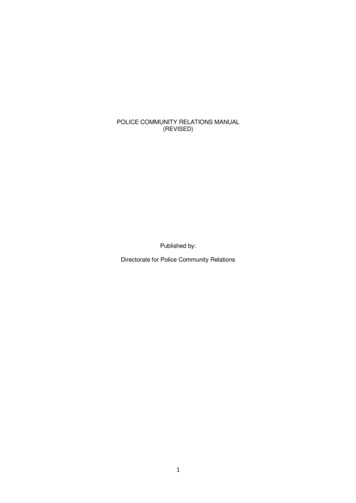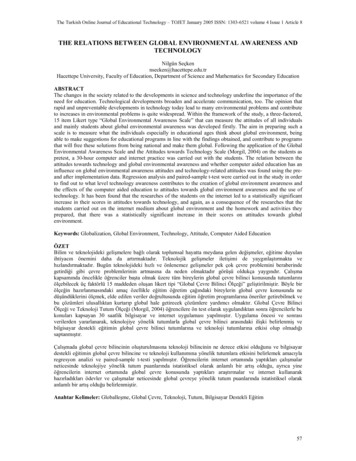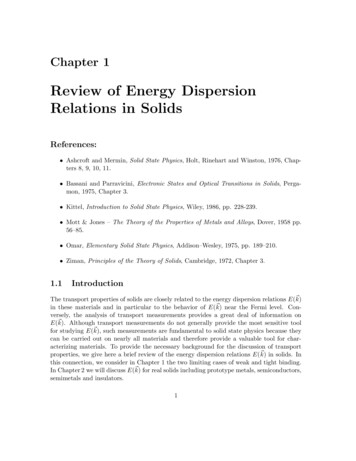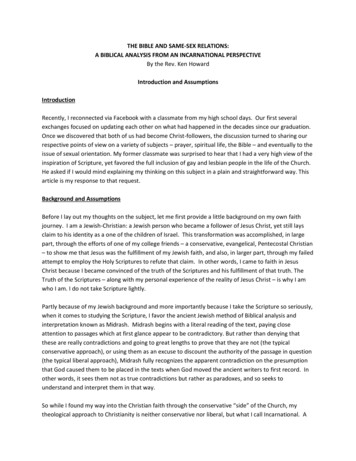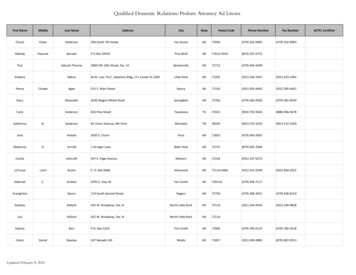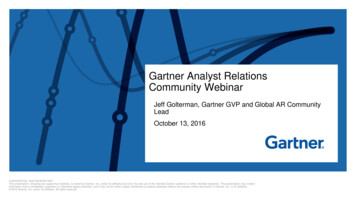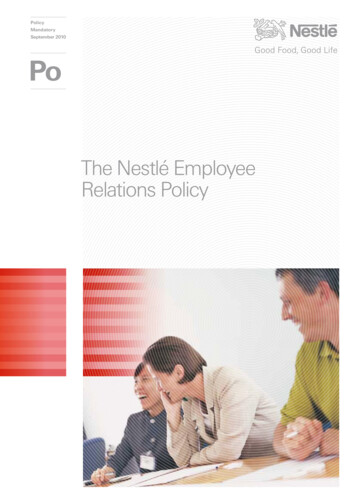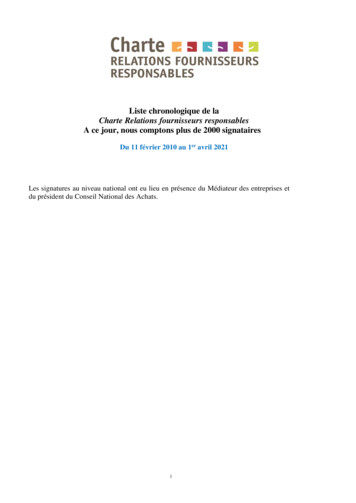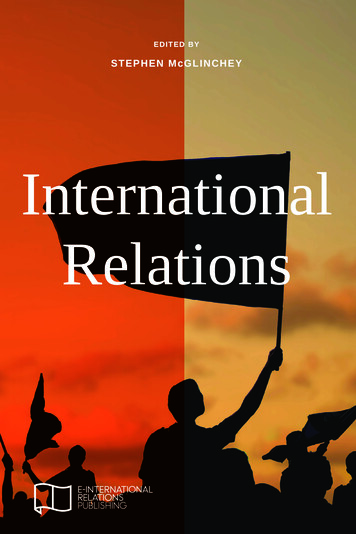
Transcription
E D IT E D B YS T E P H E N Mc GL IN CHEYInternationalRelations
This e-book is provided without charge via free download by E-InternationalRelations (www.E-IR.info). It is not permitted to be sold in electronic formatunder any circumstances.If you enjoy our free e-books, please consider leaving a small donation toallow us to continue investing in open access publications:http://www.e-ir.info/about/donate/
i“In today’s volatile and fast moving world, it is important to understand howthings really work on the global stage. This book brings together scholars andpractitioners from around the world to explain key issues, concepts anddynamics from a variety of perspectives in clear and accessible language. Aninvaluable and interesting read for anyone who wants to learn the basics ofinternational relations.”- Marta Dyczok. Associate Professor, Departments of History and PoliticalScience, University of Western Ontario.“With the turbulence all around us, everyone is affected by what happenselsewhere and no one can afford not to understand international relations.This is an essential guide to learning how to navigate our interconnectedworld”.- Mukesh Kapila, CBE. Professor of Global Health & Humanitarian Affairs,University of Manchester.“A thoughtful, well-written, intelligently presented and engaging narrativeintroduction to international relations.”- Richard Ned Lebow. Professor of International Political Theory, Departmentof War Studies, King’s College London.“A concise and comprehensive introduction to the study of internationalaffairs. Adopting a student-centred approach and using strong examples, thisbook is essential for promoting understanding about international relations.”- Yannis Stivachtis. Associate Chair, Department of Political Science, andInternational Studies Program Director, Virginia Tech.
ii
iiiInternationalRelationsED IT ED BYS T EP H E N Mc GL IN CH E Y
ivE-International Relationswww.E-IR.infoBristol, England2017ISBN 978-1-910814-17-8 (paperback)ISBN 978-1-910814-18-5 (e-book)This book is published under a Creative Commons CC BY-NC 4.0 license. Youare free to: Share – copy and redistribute the material in any medium or formatAdapt – remix, transform, and build upon the materialUnder the following terms: Attribution – You must give appropriate credit, provide a link to thelicense, and indicate if changes were made. You may do so in anyreasonable manner, but not in any way that suggests the licensorendorses you or your use.Non-Commercial – You may not use the material for commercialpurposes.Any of the above conditions can be waived if you get permission. Pleasecontact info@e-ir.info for any such enquiries, including for licensing andtranslation requests.Other than the terms noted above, there are no restrictions placed on the useand dissemination of this book for student learning materials/scholarly use.Elements of chapter seven appeared in Globalisation, Multilateralism,Europe: Towards a Better Global Governance? (Ashgate 2014). Used withpermission.Production: Michael TangCopy-editing: Gill GairdnerCover Image: yuliang11 via DepositphotosA catalogue record for this book is available from the British Library
vE-IR FoundationsSeries Editor: Stephen McGlincheyEditorial Assistants: Stacey Links, Max Nurnus, Kanica Rakhra & Rosie Walters.E-IR Foundations is a series of beginner’s textbooks from E-International Relations(E-IR) that are designed to introduce complicated issues in a practical and accessibleway. Each book will cover a different area connected to International Relations. This isthe first book in the series, with more to follow.You can find the books, and much more, on E-IR’s Student Portal:http://www.e-ir.info/studentsE-IR is developing our Foundations series as part of our mission to provide the bestsource of freely available scholarly materials for students of International Relations.Each book is available to buy in bookstores in paperback and, uniquely for textbooks,also freely accessible in web and PDF formats. So, readers can have each book attheir fingertips and on all their devices without any restrictions or hassle.Typically, textbook publishing is designed to appeal to professors/lecturers and,consequently, even the introductory books are intended less as an aid to the studentand more to assist the instructor in the classroom. Our books are designed to meet theneeds of the student, with the focus on moving readers from no prior knowledge tocompetency. They are intended to accompany, rather than replace, other texts, whileoffering the student a fresh perspective.About E-International RelationsE-International Relations is the world’s leading open access website for students andscholars of international politics, reaching over three million readers per year. E-IR’sdaily publications feature expert articles, blogs, reviews and interviews – as well asstudent learning resources. The website is run by a non-profit organisation based inBristol, England and staffed by an all-volunteer team of students and scholars.http://www.e-ir.info
viAcknowledgementsThis book would not have been possible without the assistance of E-IR’sStudent Review Panel. Members of the panel gave up their spare time to readdrafts of each chapter and offer their thoughts on how they could beimproved. The panel was chaired by Christian Scheinpflug and comprisedJanja R. Avgustin, Laura Cartner, Tom Cassauwers, Caroline Cottet, JessicaDam, Scott Edwards, Phoebe Gardner, Daniel Golebiewski, Jane Kirkpatrick,Matthew Koo, Naomi McMillen, Mohamed Osman, Robert Ralston, BryanRoh, Daniel Rowney, Ana Carolina Sarmento, Loveleena Sharma, LjupchoStojkovski, Anthony Szczurek, Jan Tattenberg and Jonathan Webb.I would also like to thank all members of the E-International Relations team,past and present, for their many acts of kindness in feeding back on ideasand providing a supportive climate for the book’s development. Of specialnote in that respect is E-IR’s co-founder Adam Groves, without whom thisproject would not have been possible.Countless others have helped me through the year-long process of movingthe book from concept to completion – especially Robert Oprisko, who wasinstrumental in getting the project off the ground during the early stages. Iwould also like to thank Michael Tang and Ran Xiao for their friendship andexpertise.This book has been developed in part due to conversations and experiencesin and around the classroom, so I would also like to thank my colleagues, andmy students, at the University of the West of England, Bristol. I am veryfortunate to be part of such a vibrant and supportive scholarly environment.Finally, and most importantly, I would like to thank the authors of each of thechapters for working so hard on this project and helping me deliver such anexcellent book.Stephen McGlinchey
vii
viiiInternational RelationsContentsCONTRIBUTORS xGETTING STARTED 1PART ONE - THE BASICS1.2.3.4.5.6.7.8.9.THE MAKING OF THE MODERN WORLDErik Ringmar8DIPLOMACYStephen McGlinchey20ONE WORLD, MANY ACTORSCarmen Gebhard32INTERNATIONAL RELATIONS THEORYDana Gold & Stephen McGlinchey46INTERNATIONAL LAWKnut Traisbach57INTERNATIONAL ORGANISATIONSShazelina Z. Abidin71GLOBAL CIVIL SOCIETYRaffaele Marchetti78GLOBAL POLITICAL ECONOMYGünter Walzenbach87RELIGION AND CULTUREJohn A. Rees98PART TWO - GLOBAL ISSUES10. GLOBAL POVERTY AND WEALTHJames Arvanitakis & David J. Hornsby113
Contentsix11. PROTECTING PEOPLEAlex J. Bellamy12312. CONNECTIVITY, COMMUNICATIONS AND TECHNOLOGYAndreas Haggman13513. VOICES OF THE PEOPLEJeffrey Haynes14414. TRANSNATIONAL TERRORISMKatherine E. Brown 15215. THE ENVIRONMENTRaul Pacheco-Vega16316. FEEDING THE WORLDBen Richardson17217. MANAGING GLOBAL SECURITY BEYOND ‘PAX AMERICANA’Harvey M. Sapolsky18318. CROSSINGS AND CANDLESPeter Vale194REFERENCES 210NOTE ON INDEXING 222
xInternational RelationsContributorsShazelina Z. Abidin is a Foreign Service officer with the Malaysian Ministryof Foreign Affairs. After postings in Washington, DC, and to the UN in NewYork, she completed her PhD at the University of Sheffield on theResponsibility to Protect.James Arvanitakis is Dean of the Graduate Research School, andProfessor, at Western Sydney University. He is also a Visiting Professor atUniversity of the Witwatersrand, South Africa.Alex J. Bellamy is Professor of Peace and Conflict Studies and Director ofthe Asia Pacific Centre for the Responsibility to Protect, University ofQueensland, Australia.Katherine E. Brown is Lecturer in Islamic Studies at the University ofBirmingham. She specialises in religious terrorism, radicalisation and counterradicalisation with a focus on questions of gender.Carmen Gebhard is Lecturer in Politics and International Relations at theUniversity of Edinburgh. She has a particular interest in small states as wellas in inter-organisational relationships in security and defence matters.Dana Gold is a Doctoral Candidate in the Department of Political Science atthe University of Western Ontario in London, Canada. Her PhD researchexplores how mental representations of the ‘Other’ are constructed andreproduced in the Israeli educational system.Andreas Haggman is a Doctoral Candidate in the Centre for DoctoralTraining in Cyber Security at Royal Holloway University of London, where heis writing his PhD thesis on wargaming cyber-attacks.Jeffrey Haynes is Professor of Politics at London Metropolitan University andDirector of the Centre for the Study of Religion, Conflict and Cooperation.David J. Hornsby is Associate Professor in International Relations andAssistant Dean of Humanities (Teaching and Learning) at the University of the
ContributorsxiWitwatersrand, Johannesburg. His research interests pertain to the politics ofscience and risk in international governance, Canadian foreign policy in SubSaharan Africa, middle power cooperation, and pedagogy in higher education.Raffaele Marchetti is Senior Assistant Professor in International Relations atthe Department of Political Science and the School of Government of LUISS,Rome. His research focuses on global politics and governance, hybriddiplomacy, transnational civil society, cyber-security and political risk anddemocracy.Stephen McGlinchey is Senior Lecturer in International Relations at theUniversity of the West of England, Bristol and Editor-in-Chief ofE-International Relations. His main research interests are in US-Iran relationsduring the Cold War.Raul Pacheco-Vega is an Assistant Professor in the Public AdministrationDivision of the Center for Economic Teaching and Research (CIDE) inMexico. His research focuses on North American environmental politics,primarily sanitation and water governance, solid waste management,neoinstitutional theory, transnational environmental social movements andexperimental methods in public policy.John A. Rees is Associate Professor of Politics and International Relations atThe University of Notre Dame Australia. He is also Convenor of the Religionand Global Society Program at Notre Dame’s Institute for Ethics and Society.Ben Richardson is an Associate Professor in International Political Economyat the University of Warwick. His research focuses on the political economy offood and agriculture.Erik Ringmar is Senior Lecturer in Political Science at Lund University,Sweden. He worked for 12 years at the London School of Economics andwas a Professor of International Relations in China for seven years.Harvey M. Sapolsky is Professor of Public Policy and Organization,Emeritus, at the Massachusetts Institute of Technology and former Director ofthe MIT Security Studies Program.Knut Traisbach is Programme Director of the Venice Academy of HumanRights at the European Inter-University Centre for Human Rights andDemocratisation, Venice.
xiiInternational RelationsPeter Vale is Director of the Johannesburg Institute for Advanced Study &Professor of Humanities at the University of Johannesburg. He is also NelsonMandela Professor of Politics Emeritus, Rhodes University.Günter Walzenbach is Senior Lecturer in European Politics at the Universityof the West of England. His main academic interest lies in the interactionbetween political and economic institutions for the purpose of social problemsolving.
1International RelationsGetting StartedBefore we go forward you should know that this book is available in e-book(PDF), web and paperback versions. While we know that many will use thedigital versions of the book, we encourage you to buy a paperback copy aswell if you are able. A growing body of research offers strong evidence that itis more effective to study from paper sources than from digital. Regardless ofhow you engage with the book, we hope it is an enjoyable read.You can get the paperback version of this book in all good bookstores – fromAmazon right down to your local bookstore – and the digital versions arealways freely available on the E-International Relations Students Portal:http://www.e-ir.info/students/HelloThis book is designed to be the very first book you will read in the area ofInternational Relations. As a beginner’s guide, it has been structured tocondense the most important information into the smallest space and presentthat information in the most accessible way.The book is split into two sections, each of nine chapters. Together they offera broad sweep of the basic components of International Relations and the keycontemporary issues that concern the discipline. The narrative arc forms acomplete circle, taking you from no knowledge to competency. Our journeywill start by examining how the international system was formed and end byreflecting that International Relations is always adapting to events and istherefore a never-ending journey of discovery.Unlike typical textbooks, there are no boxes, charts, pictures or exercises.The philosophy underpinning this book is that these things can be adistraction. This book, like others in the E-IR Foundations series, is designedto capture attention with an engaging narrative. The chapters are short, withsimple paragraphs and clear sentences.We recommend that you read the book as it is presented and avoid cherry-
Getting Started2picking chapters. Remember, the book is an unfolding narrative and eachchapter builds on the one before it. Think of it like this: you would not skip tochapter seven of a novel and expect to understand who the characters wereand what the setting was! Start at the beginning. If you find a chapter difficult,leave it for a little while then come back and give it another try. All chaptersare equally important.Key termsEach discipline has its own unique language. This comprises a range ofspecific terms that have been developed by scholars to describe certainthings. As a result, a lot of the time you spend learning a discipline is spentlearning its jargon so that you can access and understand the literature.Instead of packing this book with jargon we have tried as far as possible toexplain things in ordinary language while easing you into the more particularterminology of International Relations. This approach should keep youengaged while giving you the confidence to read the more advanced literaturethat you will soon encounter. We have also tried to avoid over-usingacronyms.Understanding key terms even applies to something as basic as how toexpress the term ‘International Relations’. The academic convention is tocapitalise it (International Relations, abbreviated as ‘IR’) when referring to theacademic discipline – that is, the subject taught in university campuses allover the world. IR does not describe events; rather, it is a scholarly disciplinethat seeks to understand events. On the other hand, ‘international relations’ –not capitalised – is generally used by both scholars and non-scholars todescribe relations between states, organisations and individuals at the globallevel. This term is interchangeable with terms such as ‘global politics’, ‘worldpolitics’ or ‘international politics’. They all mean pretty much the same thing.We have maintained this capitalisation convention in the book.IR examines just about everything that concerns how we, as human beings,have organised our world. As a discipline it is often described as ‘broadchurch’ as it has delved into other disciplines for the tools to examine thewide range of issues within its scope. Although the chapters will progressivelybuild up the picture, it may be helpful to skim through a few of the key termshere as an introduction.Political power has found its ultimate form (so far) in the creation of thenation-state. Yet, ‘nation-state’, most commonly referred to in the shorter formof ‘state’, is a jargon term that you might not often hear. Instead you may hearpeople say ‘country’ or ‘nation’. But, these terms are technically incorrect at
3International Relationsdescribing the prime units that comprise international relations. France is anation-state. It also happens to be a country and a nation, but then so isWales. But, Wales is not a nation-state. It is part of the United Kingdom,which is a nation-state because, unlike Wales, it possesses something called‘sovereignty’ – which is yet another key jargon term central to IR. Theseissues cannot be understood without IR delving into the discipline of Politicsand borrowing and adapting its insights. But you need not worry, as all theseterms are explained in the book as they appear.You may not be satisfied that international relations is just politics between oramong nation-states. Economics is also involved, and this has evolved to theextent that we are often said to be living in a globalised world characterisedby the relatively free exchanges of goods, people and information.Understandably, this adds new elements to IR and requires it to incorporatean understanding of actors beyond nation-states, such as internationalorganisations and corporations. And you may like to look even wider than therole of states, economics and organisations. Individuals – you and I – are ofcourse also important. After all, international relations is essentially a systemof interaction between human beings. To understand and analyse this, IR hashad to borrow tools from other disciplines such as Sociology. As it has doneso, it has added yet more jargon and the complexity has increased.The paragraph above also introduces the word ‘globalisation’ – a buzzword ofour time, even though scholars still heatedly debate what it actually means. Isglobalisation the description of a shared idea of what international politicsshould be? Is it a description of the growing cultural connections we shareglobally? Is it the description of a world linked by a single global economicmodel – capitalism? Is it all of these things together? Is it new or has italways existed? If we try to answer these questions we quickly find newquestions emerging, such as whether we think globalisation is a positive ornegative thing. For example, if we settle on an idea of globalisation as theemergence of a shared global culture where we all recognise the samesymbols, brands and ideals, what does that mean for local cultures andcustoms? Some even question whether globalisation exists at all. One of IR’sforemost scholars, Kenneth Waltz, famously called it ‘globaloney’.However, this book purposefully avoids getting too bogged down in bigdebates over contested terms such as globalisation. We have also avoidedpackaging complex terms in simplified definitions. Instead, where such issuesarise, we aim to give you sufficient context for you to think for yourself andread deeper and wider. We wish to open your mind, not to tell you what tothink or attempt to give you pre-packed answers.
Getting Started4IR’s dense library of key terms and jargon may appear a dizzying prospect fornew students. But, it should be clear to see how unavoidable they are andwhy IR scholars need to use them. Even making the simplest point aboutsomething within the sphere of IR draws on specific terms that need to beunderstood. Some readers of this book will not be beginners. They may havestarted their IR journey in other places and landed here for a pit stop due tojargon overload. The book is also designed with those readers in mind.We should also mention that as this book is published in the UK it ispresented in British English. This means words like ‘globalisation’ and‘organisation’ are spelt with an ‘s’ rather than a ‘z’.SourcesReferencing sources is very important in academia. It is the way scholars andstudents attribute the work of others, whether they use their exact words ornot. For that reason it is usual to see numerous references in the expertliterature you will progress to after completing this book. It is an importantelement of scholarly writing, and one that you should master for your ownstudies.In this book we have tried to summarise issues from an expert perspective soas to give you an uninterrupted narrative. When we need to point you to morespecialist literature, for example to invite you to read a little deeper, we do soby inserting in-text citations that look like this: (Vale 2016b). These point youto a corresponding entry in the references section towards the back of thebook where you can find the full reference and follow it up if you want to.Typically, these are books, journal articles or websites. In-text citations alwaysinclude the author’s surname and the year of publication. As the reference listis organised alphabetically by surname, you can quickly locate the fullreference. Sometimes you will also find page numbers inside the brackets.For example, (Vale 2016b, 11–13). Page numbers are added when referringto specific arguments, or a quotation, from a source. This referencing systemis known as the ‘Author-Date’ or ‘Harvard’ system. It is the most common, butnot the only, referencing system used in IR.When the time comes for you to make your own arguments and write yourown assignments, think of using sources as if you were a lawyer preparing acourt case. Your task there would be to convince a jury that your argument isdefensible, beyond reasonable doubt. You would have to present clear, wellorganised evidence based on facts and expertise. If you presented evidencethat was just someone’s uninformed opinion, the jury would not find itconvincing and you would lose the case. Similarly, in academic writing you
5International Relationshave to make sure that the sources you use are reputable. You can usuallyfind this out by looking up the author and the publisher. If the author is not anexpert (academic, practitioner, etc.) and/or the publisher is unknown/obscure,then the source is likely unreliable. It may have interesting information, but itis not reputable by scholarly standards.It should be safe to assume that you know what a book is (since you arereading one!) and that you understand what the internet is. However, onetype of source that you will find cited in this book and may not haveencountered before is the journal article. Journal articles are typically onlyaccessible from your university library as they are expensive and require asubscription. They are papers prepared by academics, for academics. Assuch, they represent the latest thinking and may contain cutting-edgeinsights. But, they are often complex and dense due to their audience beingfellow experts, and this makes them hard for a beginner to read. In addition,journal articles are peer reviewed. This means they have gone through aprocess of assessment by other experts before being published. During thatprocess many changes and improvements may be made – and articles oftenfail to make it through peer review and are rejected. So, journal articles aresomething of a gold standard in scholarly writing.Most journal articles are now available on the internet, which leads toconfusion as students can find it difficult to distinguish a journal article froman online magazine or newspaper article. Works of journalism or opinion arenot peer reviewed and conform to different standards. If you follow the tipabove and ‘search’ the publisher and author, you should be able to discernwhich is which. Another helpful tip is length. A journal article will typically be10–20 pages long (7,000–11,000 words); articles of journalism orcommentary will usually be shorter.A final note on the subject of sources: the internet is something of a WildWest. There is great information there, but also a lot of rubbish. It can oftenbe hard to tell them apart. But, again, if you follow the golden rule of lookingup the author and looking up the publisher (using the internet), you canusually find your way. However, even some of the world’s biggest websitescan be unreliable. Wikipedia, for example, is a great resource, but it often hasincorrect information because it is authored, and usually edited, by ordinarypeople who are typically enthusiasts rather than experts. In addition, its pagesare always changing (because of user edits), making it hard to rely on as asource. So the rule of thumb with the internet is to try to corroborate anythingyou find on at least two good websites/from at least two reputable authors.Then you can use the internet with confidence and enjoy its benefits whileavoiding its pitfalls. When preparing assignments, however, you should onlyuse the internet to supplement the more robust information you will find inacademic journals and books.
Getting Started6Read smartTry to set aside time to read. You will need to put your devices on silent, closeyour internet browsers and find a quiet space to work. Take ten-minute minibreaks every hour or so to do other things and make sure to eat a decentmeal midway through your study session to give you a longer break. Finally,get a good night’s sleep before and after you study. Your brain does notabsorb or retain information very well when you are sleep deprived or hungry.There will be times in the year when panic sets in as deadlines approach, butif you have already developed a good reading strategy you will find you are ingood shape for the task at hand.Reading for scholarly purposes is not the same as reading for pleasure. Youneed to adopt a reading strategy. Everyone has their own way of doing this,but the basic tip is this: take notes as you read. If you find that you don’t havemany notes or your mind goes a little blank, then you might be reading tooquickly or not paying enough attention. This is most likely if you are readingdigitally on a computer or tablet, as it is very easy for the eyes to wander orfor you to drift onto a social media site. If this happens, don’t worry: just goback and start again. Often, reading something a second time is when itclicks.Best practice is to make rough notes as you read through each chapter.When you get to the end of a chapter, compile your rough notes into a list of‘key points’ that you would like to remember. This will be useful when youcome to revise or recap an issue because you won’t necessarily have to readthe entire chapter again. Your notes should trigger your memory and remindyou of the key information. Some textbooks do this for you and provide a listof key points at the end of each chapter. This book, being a foundational bookfor beginners, does not do so: we want readers to develop the important skillsof reading and note-taking for themselves and not take short cuts.By making notes you will form a reading strategy that will allow you to retainthe most important information and compress it into a smaller set of notesintegral to revision for examinations and preparation for discussions andassignments. You should adopt this approach with everything you read duringyour studies. It’s best to use digital means (laptop/tablet) so you can createbackups and not risk losing valuable handwritten paper notes. You shouldalso note down the citation information for each set of notes at the top of thepage so that you can identify the source you took the notes from if you needto reference it later in any written work.
7Part OneTHE BASICS
The Making of the Modern World81The Making of the ModernWorldE R IK R IN GM ARInternational relations, as it is presented in the flow of daily news, concerns alarge number of disparate events: leaders are meeting, negotiations areconcluded, wars are started, acts of terror committed, and so on. In order tomake sense of all this information we need to know a lot about thecontemporary world and its history; we need to understand how all thedisparate events hang together. At university, we study these topics, but it is abasic tenet of the academic study of international politics that this rathermessy picture can be radically simplified. Instead of focusing on the flow ofdaily news, we focus on the basic principles underlying it. This is what we willtry to do in this chapter. So, let us begin by thinking big: what is internationalrelations, how was it made, and how did it come to be that way?The state is a good place to start. There are a lot of states in the world – infact, according to the latest count, there are no fewer than 195 of them.States are obviously very different from each other, but they are also similarto each other in important respects. All states are located somewhere, theyhave a territorial extension; they are surrounded by borders which tell uswhere one state ends and another begins. In fact, with the exception ofAntarctica, there is virtually no piece of land anywhere on earth’s surface thatis not claimed by one state or another and there is no piece of land thatbelongs to more than one state (although, admittedly, the ownership of somepieces of land is disputed). Moreover, all states have their own capitals,armies, foreign ministries, flags and national anthems. All states callthemselves ‘sovereign’, meaning that they claim the exclusive right to governtheir respective territories in their own fashion. But states are also sovereignin relation to each other: they act in relatio
ISBN 978-1-910814-18-5 (e-book) This book is published under a Creative Commons CC BY-NC 4.0 license. You are free to: Share – copy and redistribute the material in any medium or format Adapt – remix, transfor
